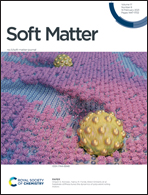Dynamics of the sub-ambient gelation and shearing of solutions of P3HT and P3HT blends towards active layer formation in bulk heterojunction organic solar cells†
Abstract
Organic solar cells (OSCs) containing an active layer consisting of a nanostructured blend of a conjugated polymer like poly(3-hexylthiophene) (P3HT) and an electron acceptor have the potential of competing against silicon-based photovoltaic panels. However, this potential is largely unfulfilled first due to interrelated production and stability issues of organic solar cells and second due to the unscalable nature of the generally employed spin coating process used for the fabrication of organic solar cells. Furthermore, alternatives to spin coating, especially relying on continuous polymer processing methods like extrusion and coating, cannot be readily applied due to the typically low shear viscosity and elasticity of polymer solutions making up the active layer. Recently, He et al. have reported that the gelation of P3HT with [6,6]-phenyl-C61-butyric acid methyl ester (PC60BM) under sub-ambient conditions can provide a new route to the processing of the active layers of bulk heterojunction solar cells. Furthermore, increases in power conversion efficiencies (PCEs) of the P3HT/PC60BM active layer were determined to be possible under certain shearing and thermal histories of the P3HT/PC60BM gels. Here oscillatory and steady torsional flows were used to investigate the gel formation dynamics of P3HT with a recently proposed non-fullerene acceptor o-IDTBR under sub-ambient conditions and compared with the gelation behavior of P3HT/PC60BM blends. The rheological material functions as well as the gel strengths defined on the basis of linear viscoelastic material functions, characterized via small-amplitude oscillatory shearing, were observed to be functions of the P3HT and o-IDTBR concentrations, the solvent used and the shearing conditions. Overall, the P3HT gels which formed upon quenching to sub-zero temperatures were found to be stable during small-amplitude oscillatory shear (linear viscoelastic range) but broke down even at the relatively low shear rates associated with steady torsional flows, suggesting that the shearing conditions used during the processing of gels of P3HT and blends of P3HT with small molecule acceptors can alter the gel structure, possibly leading to changes in the resulting active layer performance.



 Please wait while we load your content...
Please wait while we load your content...